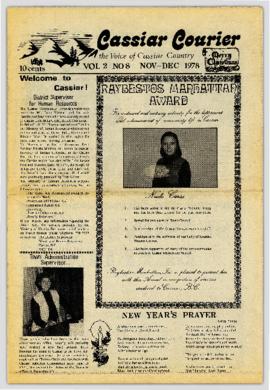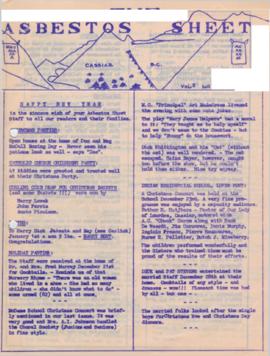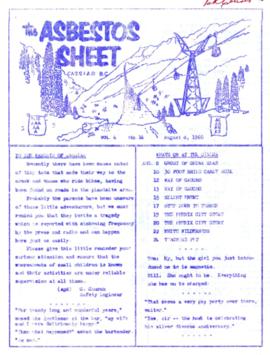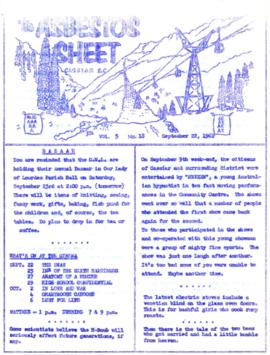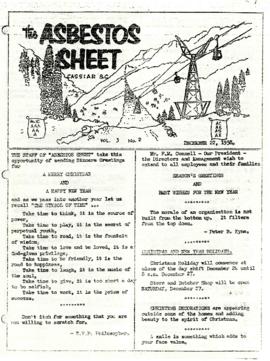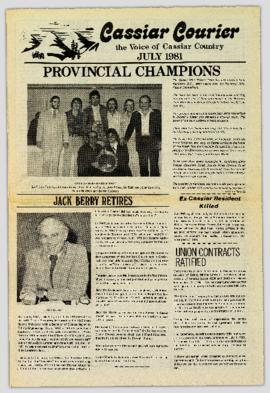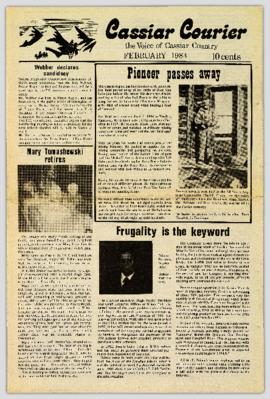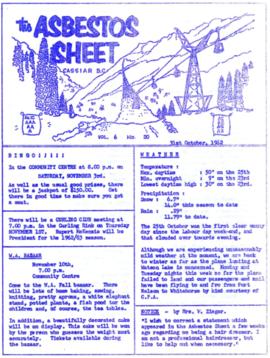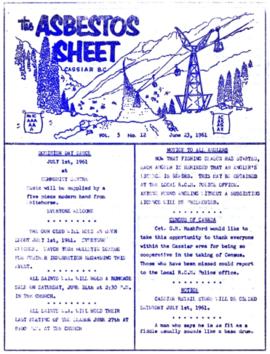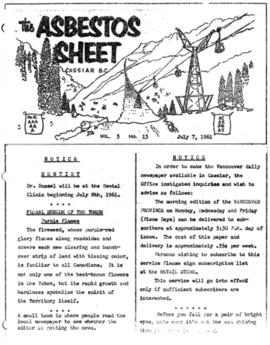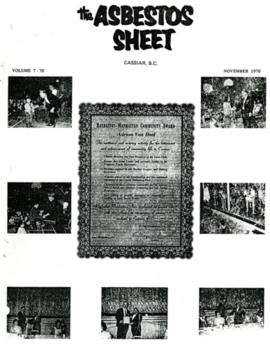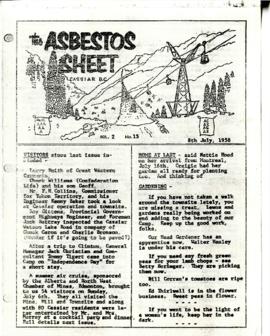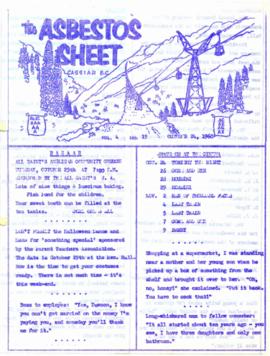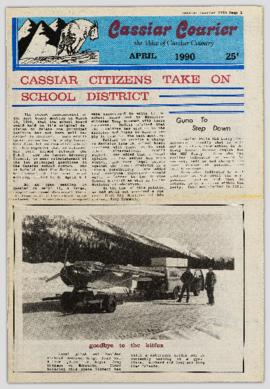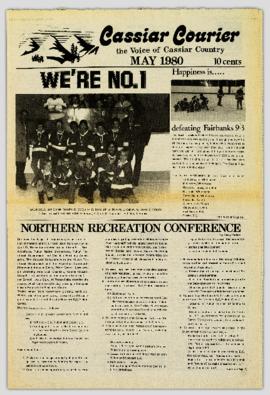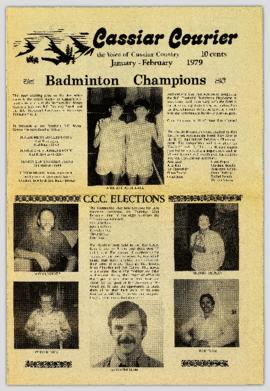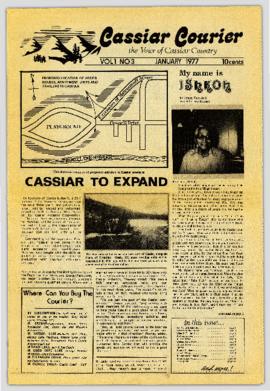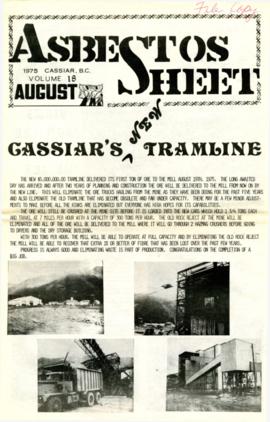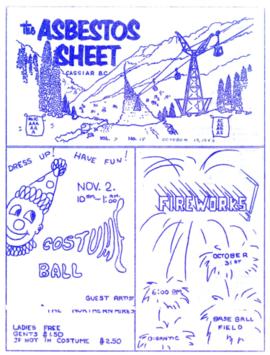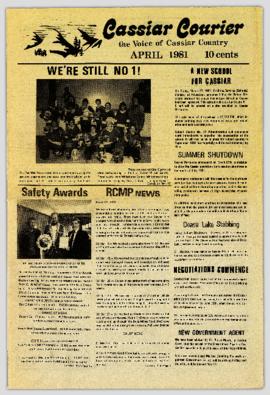"The Cassiar Courier" is a newspaper that documents the community and work life of the residents of Cassiar BC. Content includes text and photographs, as well as jokes, comics, and games.
"The Asbestos Sheet" is a newspaper that documents the community and work life of the residents of Cassiar BC. Content includes text and photographs, as well as jokes, comics, and games.
"The Asbestos Sheet" is a newspaper that documents the community and work life of the residents of Cassiar BC. Content includes text and photographs, as well as jokes, comics, and games.
"The Asbestos Sheet" is a newspaper that documents the community and work life of the residents of Cassiar BC. Content includes text and photographs, as well as jokes, comics, and games.
"The Asbestos Sheet" is a newspaper that documents the community and work life of the residents of Cassiar BC. Content includes text and photographs, as well as jokes, comics, and games.
File contains correspondence, memoranda, interoffice communications, informational/promotional material, and reports on varying subjects.
James Maclaren Industries Inc.File contains executive correspondence regarding Maclaren and Northwood. Includes letters of resignation.
James Maclaren Industries Inc.Item contains the minutes from the 1980 Maclaren directors meeting.
James Maclaren Industries Inc.Item contains the minutes from the 1980 Maclaren directors meeting.
James Maclaren Industries Inc.File contains a minutes of the 1981 directors meeting of Maclaren.
James Maclaren Industries Inc.File contains a minutes of the 1982 directors meeting of Maclaren.
James Maclaren Industries Inc.File contains a copy of a report entitled "James Maclaren Industries Inc Newsprint Division - Newsprint Mill Modernization".
James Maclaren Industries Inc.File contains promotional material, a proposal by Maclaren to invest in Perron, snd minutes from a meeting of the executive committee.
James Maclaren Industries Inc.File contains correspondence, memoranda, other interoffice communications, and reports.
James Maclaren Industries Inc.File contains several copies of the Normick Perron annual report: 1980, 1981, 1982, 1984, 1986, 1987.
James Maclaren Industries Inc."The Cassiar Courier" is a newspaper that documents the community and work life of the residents of Cassiar BC. Content includes text and photographs, as well as jokes, comics, and games.
"The Cassiar Courier" is a newspaper that documents the community and work life of the residents of Cassiar BC. Content includes text and photographs, as well as jokes, comics, and games.
"The Asbestos Sheet" is a newspaper that documents the community and work life of the residents of Cassiar BC. Content includes text and photographs, as well as jokes, comics, and games.
File contains timber sale contracts and logging inspection reports between the Department of Lands and Forests and the Fichtner Lumber Company Limited.
"The Asbestos Sheet" is a newspaper that documents the community and work life of the residents of Cassiar BC. Content includes text and photographs, as well as jokes, comics, and games.
"The Asbestos Sheet" is a newspaper that documents the community and work life of the residents of Cassiar BC. Content includes text and photographs, as well as jokes, comics, and games.
"The Asbestos Sheet" is a newspaper that documents the community and work life of the residents of Cassiar BC. Content includes text and photographs, as well as jokes, comics, and games.
"The Asbestos Sheet" is a newspaper that documents the community and work life of the residents of Cassiar BC. Content includes text and photographs, as well as jokes, comics, and games.
"The Asbestos Sheet" is a newspaper that documents the community and work life of the residents of Cassiar BC. Content includes text and photographs, as well as jokes, comics, and games.
"The Cassiar Courier" is a newspaper that documents the community and work life of the residents of Cassiar BC. Content includes text and photographs, as well as jokes, comics, and games.
Item contains the meeting meetings of the annual shareholder's meeting.
James Maclaren Industries Inc.File contains a minutes of the 1982 directors meeting of Maclaren.
James Maclaren Industries Inc.File contains various correspondence regarding the activities of the Maclaren company.
James Maclaren Industries Inc.Item contains the 1981 business plan for Maclaren.
James Maclaren Industries Inc.File contains a proposal to upgrade the current low yield sulphite mill to an ultra high yield system.
James Maclaren Industries Inc.File contains an informational package containing cost estimates, marketing strategies, financial information, environmental considerations, manpower, and training, regarding the expansion of the Thurso Kraft Mill.
James Maclaren Industries Inc.File contains correspondence, memoranda, other interoffice communications, and reports.
James Maclaren Industries Inc.File contains Adam Zimmerman's meeting notes, meeting agendas and minutes.
James Maclaren Industries Inc.File contains correspondence, meeting schedules, minutes, and notes regarding the purchase of Normick Perron by Noranda Forest Industries.
James Maclaren Industries Inc."The Cassiar Courier" is a newspaper that documents the community and work life of the residents of Cassiar BC. Content includes text and photographs, as well as jokes, comics, and games.
"The Cassiar Courier" is a newspaper that documents the community and work life of the residents of Cassiar BC. Content includes text and photographs, as well as jokes, comics, and games.
File consists of a speech given by Gary Runka entitled "Agriculture in the Urban Shadow" at the Agricultural Land Commission Symposium - Urban Growth and the Agricultural Land Reserve: 'Up not Out' - March 9,1993.
Commentary on this speech by Barry Smith of the Ministry of Agriculture and Lands:
"This represents an important, highly pertinent speech concerning farmland preservation in B.C. The speech was given at the ALC Symposium marking the 20th anniversary of B.C.'s farmland preservation program. The speech rings as relevant today as it did when delivered 22 years ago.
It begins by identifying two perspectives - one, those committed to an agricultural future, contributing diversity and having a social value and two, those that feel agriculture is ultimately doomed and is only an interim use, especially in the urban shadow, until a "higher and better" use comes along. GGR states that we need to honestly state which perspective we are guided by.
There are a host of important themes woven through this paper including:
- While farming on the urban shadow benefits both the urban and farm communities, the negative impacts of urban/farm adjacency are predominantly borne by the agricultural community.
- In describing the situation prior to the farmland preservation legislation in the 1960's and early 1970's agriculture was consistently the "loser user".
- Even in the earliest days of the Commission, urban shadow issues were identified and the ALC recognized that provincial zoning was only a first step, and taken alone, was not enough.
- The BC farmland preservation program has been at least as successful as anywhere else in North American and looked on with envy in many other jurisdictions.
- GGR believes that after 20 years we are worse off today than when the program started due to (i) elected provincial politicians involved with the application process (ii) the ALR / Golf Course fiasco and (ill) the ALC has become paralyzed in their Appeal Board mode.
Several (13 starting on p. 7) urban shadow issues are outlined and GGR states that we must be serious about addressing urban shadow issues.
The paper ends with an outline of "where we need to be tomorrow" and GGR states: "I recall when the program began in 1973 we argued that all of the compromises with respect to agriculture had already been made, if we were to keep the options open for future
generations In British Columbia. If that statement was true then, how much more true is it today, 20 years later?"
From the Symposium concluding remarks, Gary Runka stated that based on his experience and discussions during the symposium, he believed that the following initiatives should be given priority:
- Information and education programs
- Communication between farmers, government and the public
- Regional land use planning
- Integration of government policies to a strong farmland preservation strategy
- Provincial agricultural strategy
- Programs which insure farms can be viable
The Symposium proceedings have been compiled in a 67 page ALC publication."
"The Cassiar Courier" is a newspaper that documents the community and work life of the residents of Cassiar BC. Content includes text and photographs, as well as jokes, comics, and games.
"The Asbestos Sheet" is a newspaper that documents the community and work life of the residents of Cassiar BC. Content includes text and photographs, as well as jokes, comics, and games.
File contains the minutes of the 1980 directors meeting of Maclaren.
James Maclaren Industries Inc.File contains a minutes of the 1982 directors meeting of Maclaren.
James Maclaren Industries Inc.File contains a complete list of every shareholder in Maclaren Power & Paper as of year's end 1979.
James Maclaren Industries Inc.File contains an official proposal by Noranda to purchase class A and B shares of Maclaren Power & Paper.
James Maclaren Industries Inc.File contains Noranda's proposal to buy Maclaren Power & Paper.
James Maclaren Industries Inc.File contains a booklet containing an in depth proposal for a major investment by Maclaren Power & Paper.
James Maclaren Industries Inc.File contains a "Report of Lavery, O'Brien regarding Ottawa Valley Power Company".
James Maclaren Industries Inc.File contains a booklet outlining the planned expenditures to maintain current production levels in the pulpmill division.
James Maclaren Industries Inc."The Asbestos Sheet" is a newspaper that documents the community and work life of the residents of Cassiar BC. Content includes text and photographs, as well as jokes, comics, and games.
"The Cassiar Courier" is a newspaper that documents the community and work life of the residents of Cassiar BC. Content includes text and photographs, as well as jokes, comics, and games.
